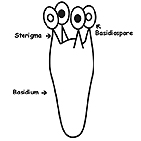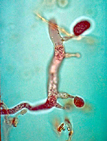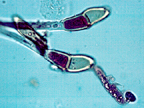




Basidiomycota
This division has many features in common with the
Ascomycota: mycelia with chitinous cell walls that are regularly septate, presence of an
extended dikaryon stage, yeast stage and presence of macroscopic fruiting bodies, in some
taxa, and conidia are produced if an asexual stage is present. As in the Ascomycota and
Zygomycota, the characteristic that defines this subdivision is the sexual spore stage.
The sexual spores produced are basidiospores that are typically borne, exogenously,
on horn-like sterigmata (sing.=sterigma) of basidia (sing.= basidium) (Fig.
1). The morphology of the basidium, however, is variable and a few of the variations are
shown in the micrographs below (Figs. 2-4), and the variations observed below were once
thought to be of considerable significance in the phylogeny of the Basidiomycota.
Three classes are currently recognized:
Go to Next Page